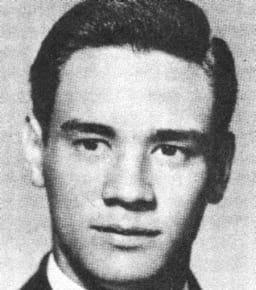
While most of his coaches and the leading sportswriters throughout his career referred to his physical stature as “small” or ‘light” for a football end, they attributed Dukie’s success to skill, speed, quickness, savvy, and – heart! (His playing weight never exceeded 169 pounds.)This article appears as originally published in the Summer 1994 issue of the Punahou Bulletin.
At Punahou he starred in football and baseball. His football career began on the J.V. team (first team end – two years) and culminated as the varsity starting end at either offense of defense in his junior and senior years (two letters). His outstanding performances won him All-Star Honorable Mention in 1948 and All-Star Second Team honors in 1949. He was selected to play in the Shriners Hospital Aloha Bowls (Keiki Ali’is vs. Keiki Kanes) in both 1948 and 1949.
Dukie was particularly outstanding in baseball, where he was the starting center fielder for four years – with four letters! Captain of the 1950 squad, he was the leader of the ILH league in stolen bases. His performances won him All-Star honors n both his junior and senior years. His baseball coach, Jim Doole, selected him as the best center fielder during Jim Iams 15-year tenure as Punahou’s Athletic Director. At Purdue, Dukie devoted his energy to football, where he won four letters as the varsity team’s star end (again – both on offense and defense!). During his college football career, he won the following honors:
All Big 10 Conference, End, Honorable Mention, 1952. Team co-captain, 1953 and 1954.
United Press All American Football Team, End, 1953. (Inside Sports Magazine referred to him as “the finest two-way end in the Big 10”.)
Leading Pass Receiver, Big 10 Conference, 1954.
All Big 10 Conference, End second team, 1954 (by both United Press and Associated Press).
Selected to play in both the East-West Shrine Game and the Hula Bowl, 1955.
Drafted by the San Francisco 49ers, 1955. (He turned the 49ers down, electing to fulfill the military service commitment he had made.)
Dukie obtained two masters degrees; in Physical Education (at Purdue), and General Science (at Oregon State University).
Returning to Hawaii, he spent 35 years in education; 31 years as a teacher (including 22 in coaching) and four years as an administrator – most of it on the Big Island, where he currently lives. He retired June 30, 1993.
